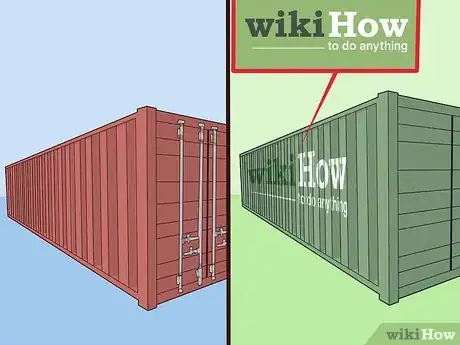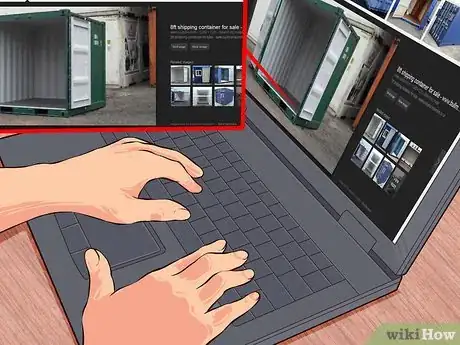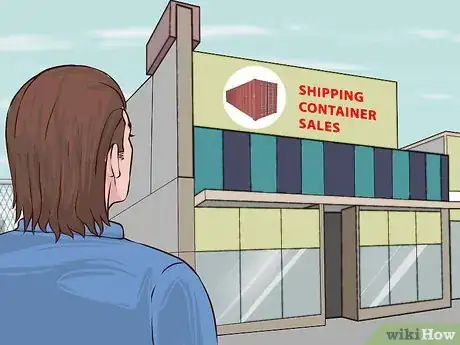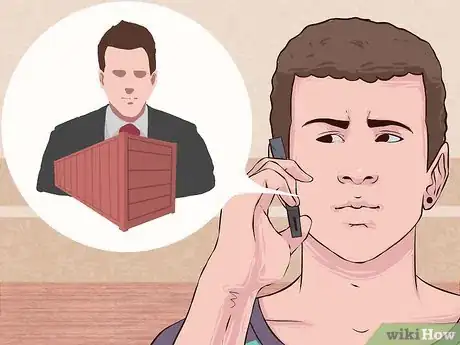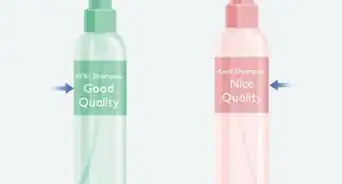This article was co-authored by Marty Stevens-Heebner, SMM-C, CPO®. Marty Stevens-Heebner is a Certified Professional Organizer (CPO) and Founder of Clear Home Solutions, a home organizing and senior moving management company based in southern California. Marty is the first Certified Senior Move Manager (SMM-C) in the United States and is a Certified Aging in Place Specialist (CAPS) through the National Association of Home Builders. She is the President-Elect and is on the board of directors of the National Association for Senior Move Managers, a member of the National Association of Professional Organizers, and has been acknowledged as a Hoarding Specialist and ADHD Specialist through the Institute for Challenging Disorganization.
This article has been viewed 49,379 times.
Whether you’re buying a container for shipping, to convert for residential use, for storage purposes, or for some other purpose, the process is not difficult. However, you should make sure you are purchasing from a reputable source, and that you are getting a good deal. Before purchasing a container, take steps to make sure you are getting the container you want for the best price.
Steps
Choosing the Right Container
-
1Find the right grade. Containers come in several grades, which provides information about how the container was used before it went up for sale. What grade you needs depends on what you need it for.
- "New" or "one-trip" containers have typically been made in China and then shipped directly to the United States. If you want to convert your container into a home, this is the best option, as it will be weather resistant, and have the least damage.
- "Cargo-worthy" containers have been used a bit more, but are still in good condition, and could be used at sea again. Typically these will be wind and water tight, and, structurally speaking, would still be able to handle being shipped overseas.
- "Wind and water tight" containers are those that are still able to keep out the elements, but have not been officially inspected in order to be declared “cargo-worthy”.
- "As is" containers are those that may or may not be able to stand up to the elements, and may or may not have structural damage.
-
2Decide between steel or aluminium. Different containers are made of different materials. All containers that were used for overseas shipping are made of steel, and are much stronger than their aluminium counterparts.
- If you wish to live in the container, you will need to purchase a steel container, as these are much stronger and more durable (they were made for trips across the ocean, after all). However, if you only need it for a temporary storage solution, and aren’t worried about the weather, an aluminum container could suffice.
Advertisement -
3Consider Size and Space. Initially, you have to consider the size of the container you need. You need to have the container's physical space to occupy and space for the delivery truck to move. Trucks will have to move wide turns as well as a maneuver to set up your delivery securely. The truck itself is about 10' wide and requires a minimum of a foot on each side for 12' in total. The space for navigating the delivery is as follows: 20’ container = 60′ 40’ containers = 120′.[1]
- Containers also come in various sizes. You may want a larger or smaller container depending on what you need it for.
- Containers range in length from 20 feet (6 meters) up to 53 feet (16 meters).
- They range in height from 8 feet 6 inches (2.6 meters) up to 9 feet 6 inches (2.9 meters).
- Width ranges are between 8 feet (2.4 meters) and 8 feet 6 inches (2.6 meters)
-
4Consider the outside of the container. Some containers will come in a plain color, while some may have the logo of the company that used them for shipping goods. If you plan to repaint the container, it doesn’t matter much. However, if you don’t plan to repaint it, you should choose a container with a color and/or design you don’t mind looking at.[2]
-
5Consider what the container was used for. Some containers, for example, might have been used to transport goods with a very strong odor, such as animal hides. In this case, you may end up with a shipping container that is contaminated by a strong, foul odor.
Finding the Right Container
-
1Consider your location. Depending on your location, the cost and availability of used shipping containers can vary greatly. If you’re near a coast or major urban center, the cost could be more reasonable than if you’re in a rural area.
- If you live in a more rural, in-land area, you could compare the cost of purchasing a container locally with the cost of purchasing a container from an area where they are cheaper plus the cost of transporting it to you.
- If you live in an area where containers are in high demand, but not close to a big city or harbor, then a locally bought container could be extremely expensive. On the other hand, you might be able to find a container in the nearest port city to you (or big city), and have it shipped. In this instance the price of the container and the price of the shipping together could be significantly less expensive than purchasing a local container.
- One big disadvantage here is that you probably won’t get the opportunity to inspect the container before buying.
- Depending on where you live, you should expect to spend between $2,500 and $4,000 on a one-trip 20’ container. Prices will be higher for a larger container.[3]
- If you are purchasing a brand new container, which will likely be shipped from Asia, you should expect to spend significantly more, especially when it comes to delivery costs.
-
2Consider shipping costs. If you live very close to the dealer you are purchasing your container from, you may not have to pay anything at all for delivery. However, if you live farther away, you will need to pay for shipping costs. This will depend on what you are able to negotiate with the seller.
- You could estimate that you will spend about $400 to ship a 20’ container approximately 300 miles, including unloading and surcharges.[4] However, this is just one estimate. You should discuss the cost of delivery with the seller, as some sellers may have other offers.
- For a container shipped internationally, you could expect to spend anywhere from $1,900 up to $23,000 for a new container that has never been used, depending upon the distance shipped, and how many containers you are shipping.[5]
- You could also reduce the cost of shipping in this instance, by allowing the company to use the container to ship goods. Obviously it will no longer be brand new, but it will help reduce your costs.[6]
-
3Search local classified ads. You can look in your local newspaper or at online classified ads. You may find someone selling one privately for a good deal.
- You can search online for classified ads by typing “shipping container for sale” + the name of your town, city, or county.
- Be sure to see the container in person before handing over any money to a private seller! Sometimes, classified ads are merely scams.
-
4Look for companies that sell containers. Some shipping and leasing companies will sell directly to private buyers, while some large container companies don’t want to deal with buyers who only want to purchase one or a few containers. [7]
- Searching the internet for “shipping containers for sale” is a good way to find companies selling to private consumers; however, you should research the company carefully. This website allows you to search for reputable sellers based on country, state, or province.
- You can also search your local newspapers and classified ads for shipping container dealers.
-
5Make a list. Throughout your search, you should make a list of the names, phone numbers, and websites of the dealers you think may be able to offer what you are looking for. This way, you will be able to compare offers, and get the best deal on the container you want.
Purchasing the Container
-
1Contact the seller. You can do this either by email or phone, and tell them specifically what you're looking for in order to find out of they can supply a container that meets your needs.
- If you have found several potential dealers, you should consider contacting all of them to see who will give you the best deal. If there is one who will allow you to see the container, it might be wise to go with them simply because you will get a chance to inspect the quality.
-
2Ask to see the container. Ask the seller to give you a chance to examine the container. However, be aware that this may not always be possible as some sellers may have thousands upon thousands of containers in the depot.
-
3Inspect the container. If the seller will allow you to, examine the container you will be purchasing carefully.
- If you need the container to be wind and water tight, go inside the container and shut the door. It will be dark, so you should look for any places where light shines through. If you find a place, this means that it may not be able to protect you or your things from the elements.
- Make sure the doors close properly, and that there are no huge dents in the container.[8]
- Containers tend to rust a bit, especially if they are not “new”, but you should look for areas where the container is rusted through.[9]
-
4Negotiate shipping. If you need to have your container shipped to you, it is recommended that you do your best to request delivery via a tilt bed roll off truck.[10]
- Remember though, that unloading, especially if you are having the delivery person place it in a specific way, will cost extra. The price may be included, but it may not be, and it can vary greatly. Make sure you negotiate this cost with the seller.
- Containers weigh, depending on size, approximately 5,000 pounds (2,268 kilos), so you definitely can’t manage it alone![11]
- If you want to have your shipping container placed in an area that doesn't have much cleared space, then you may have to hire someone with a crane to lift the container into the desired position.
-
5Negotiate an offer. In countries such as the US, most dealers have many more containers than they need, so it is in their interest for you to purchase one. This gives you the power to negotiate the price with the dealer! If they won’t budge on the price, try asking for free delivery.[12]
- Although you should negotiate the price, avoid taking advantage of the seller. He or she will know that you are, as they know the going rate. They will be less likely to work with you if they feel you are trying to take unfair advantage over them.
References
- ↑ https://www.sigmacontainer.ca/where-we-serve/toronto/
- ↑ http://www.dwell.com/how/article/how-buy-shipping-container
- ↑ http://www.jetsongreen.com/2010/02/ten-things-consider-shipping-container-projects.html
- ↑ http://www.containerhomeplans.org/2015/07/how-much-does-it-cost-to-transport-a-shipping-container/
- ↑ http://www.containerhomeplans.org/2015/07/how-much-does-it-cost-to-transport-a-shipping-container/
- ↑ http://www.containerhomeplans.org/2015/07/how-much-does-it-cost-to-transport-a-shipping-container/
- ↑ http://www.containerhomeplans.org/2015/03/where-can-i-buy-shipping-containers-from/
- ↑ http://www.dwell.com/how/article/how-buy-shipping-container
- ↑ http://www.dwell.com/how/article/how-buy-shipping-container
About This Article
To buy a shipping container, start by looking through local classifieds in newspapers or online to find someone that's selling one. Alternatively, you can contact shipping companies, which often sell containers at cheaper rates. Once you’re ready to contact a seller, explain you want a one trip or cargo-worthy container if you need one that's watertight. Alternatively, ask for a steel container if you want your container to be strong. Then, negotiate a price and delivery charge with the seller. For tips on how to inspect a container before buying it, keep reading!



